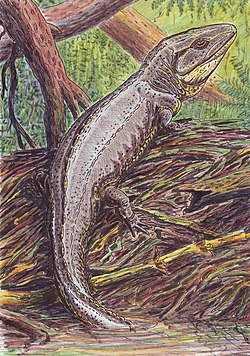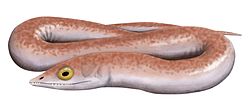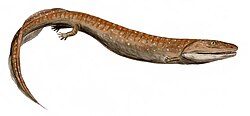| Proterogyrinus | |
|---|---|
 | |
| Skull diagram | |
| Scientific classification | |
| Kingdom: | Animalia |
| Phylum: | Chordata |
| Order: | † Embolomeri |
| Family: | † Proterogyrinidae |
| Genus: | † Proterogyrinus Romer, 1970 |
| Type species | |
| †Proterogyrinus scheelei Romer, 1970 | |
| Other species | |
| |
| Synonyms | |
| |

Proterogyrinus is an extinct genus of early tetrapods from the order Embolomeri. Fossil remains of Proterogyrinus have been found in Scotland, UK, and West Virginia, United States, and date back to the Serpukhovian (mid-Carboniferous period), which is from about 331 to 323 million years ago. [1] The genus was originally named by renowned vertebrate paleontologist Alfred Sherwood Romer in 1970. [2] A comprehensive redescription was later published by Canadian paleontologist Robert Holmes in 1984. [3] The generic name "Proterogyrinus" is Greek for "earlier wanderer" or "earlier tadpole". This name was chosen by Romer in keeping with a trend of naming long-bodied early tetrapods (such as Eogyrinus and Crassigyrinus ) with the suffix "-gyrinus". [2]
Romer hesitated from designating Proterogyrinus as a true embolomere, because its intercentra (the forward portion of each vertebra) were smaller than its pleurocentra (the rear portion). He used the group Anthracosauria to encompass embolomeres and their close relatives such as Proterogyrinus. [2] However, other sources prefer a wider definition of Embolomeri similar in usage to Romer's Anthracosauria, thus counting Proterogyrinus as an embolomere. [3]





